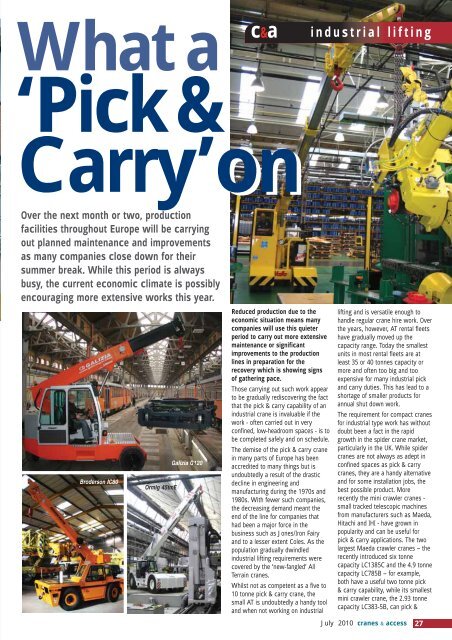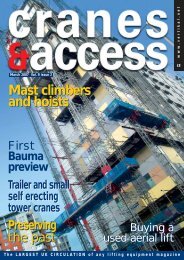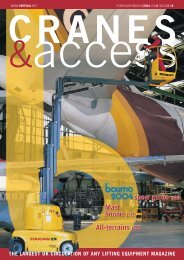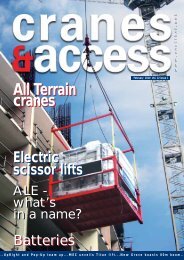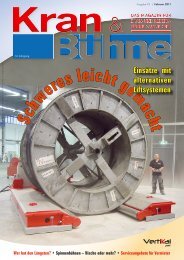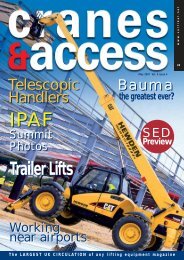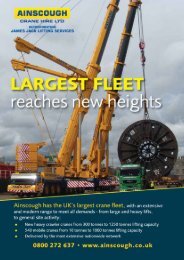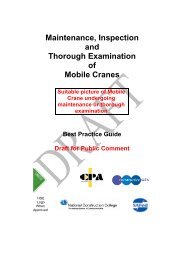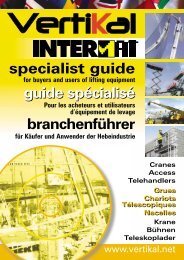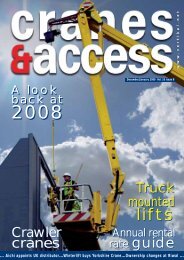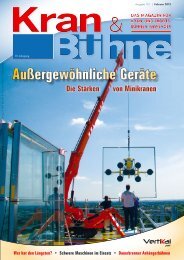Selling
Selling
Selling
Create successful ePaper yourself
Turn your PDF publications into a flip-book with our unique Google optimized e-Paper software.
What a<br />
c&a<br />
‘Pick&<br />
Carry’on on<br />
Over the next month or two, production<br />
facilities throughout Europe will be carrying<br />
out planned maintenance and improvements<br />
as many companies close down for their<br />
summer break. While this period is always<br />
busy, the current economic climate is possibly<br />
encouraging more extensive works this year.<br />
Broderson IC80<br />
Ormig 45tmE<br />
Galizia G120<br />
Reduced production due to the<br />
economic situation means many<br />
companies will use this quieter<br />
period to carry out more extensive<br />
maintenance or significant<br />
improvements to the production<br />
lines in preparation for the<br />
recovery which is showing signs<br />
of gathering pace.<br />
Those carrying out such work appear<br />
to be gradually rediscovering the fact<br />
that the pick & carry capability of an<br />
industrial crane is invaluable if the<br />
work - often carried out in very<br />
confined, low-headroom spaces - is to<br />
be completed safely and on schedule.<br />
The demise of the pick & carry crane<br />
in many parts of Europe has been<br />
accredited to many things but is<br />
undoubtedly a result of the drastic<br />
decline in engineering and<br />
manufacturing during the 1970s and<br />
1980s. With fewer such companies,<br />
the decreasing demand meant the<br />
end of the line for companies that<br />
had been a major force in the<br />
business such as Jones/Iron Fairy<br />
and to a lesser extent Coles. As the<br />
population gradually dwindled<br />
industrial lifting requirements were<br />
covered by the ‘new-fangled’ All<br />
Terrain cranes.<br />
Whilst not as competent as a five to<br />
10 tonne pick & carry crane, the<br />
small AT is undoubtedly a handy tool<br />
and when not working on industrial<br />
industrial lifting<br />
lifting and is versatile enough to<br />
handle regular crane hire work. Over<br />
the years, however, AT rental fleets<br />
have gradually moved up the<br />
capacity range. Today the smallest<br />
units in most rental fleets are at<br />
least 35 or 40 tonnes capacity or<br />
more and often too big and too<br />
expensive for many industrial pick<br />
and carry duties. This has lead to a<br />
shortage of smaller products for<br />
annual shut down work.<br />
The requirement for compact cranes<br />
for industrial type work has without<br />
doubt been a fact in the rapid<br />
growth in the spider crane market,<br />
particularly in the UK. While spider<br />
cranes are not always as adept in<br />
confined spaces as pick & carry<br />
cranes, they are a handy alternative<br />
and for some installation jobs, the<br />
best possible product. More<br />
recently the mini crawler cranes -<br />
small tracked telescopic machines<br />
from manufacturers such as Maeda,<br />
Hitachi and IHI - have grown in<br />
popularity and can be useful for<br />
pick & carry applications. The two<br />
largest Maeda crawler cranes – the<br />
recently introduced six tonne<br />
capacity LC1385C and the 4.9 tonne<br />
capacity LC785B – for example,<br />
both have a useful two tonne pick<br />
& carry capability, while its smallest<br />
mini crawler crane, the 2.93 tonne<br />
capacity LC383-5B, can pick &<br />
July 2010 cranes & access 27


